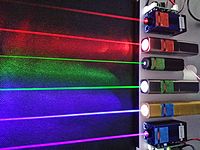
Photo from wikipedia
Conjugated organic polymers (COPs) have been excellent candidates because the conjugated structure occupied π structure that was useful to develop light-emitting materials. However, most COPs emitted weak luminescence owing to… Click to show full abstract
Conjugated organic polymers (COPs) have been excellent candidates because the conjugated structure occupied π structure that was useful to develop light-emitting materials. However, most COPs emitted weak luminescence owing to the H-aggregation effect. Light-emitting conjugated organic polymers (LCOP-1) possessed rich butyl groups anchored in the skeleton to enhance light-emitting activity via reducing the H-aggregation effect. Owing to abundant hydroxyl and nitrogen atoms, LCOP-1 exhibited high sensitivity, selectivity, and fast response to Cu2+ ions within one minute in comparison with the cations of Na+ , Mg2+ , Al3+ , Zn2+ , Cd2+ , Ni2+ , Cr3+ , Hg2+ , Fe3+ , Fe2+ , Pb2+ , Co2+ , etc. The detection limit could be down to nanomolar. Moreover, the sensor exhibited detection toward Cu2+ ions via a naked eye colourful change from pale-yellow to yellowish-brown. Furthermore, the light-emitting probe also successfully achieved the detection of Cu2+ ions in cells without cytotoxicity, indicating its great potentials in biological function. This article is protected by copyright. All rights reserved.
Journal Title: Macromolecular rapid communications
Year Published: 2021
Link to full text (if available)
Share on Social Media: Sign Up to like & get
recommendations!